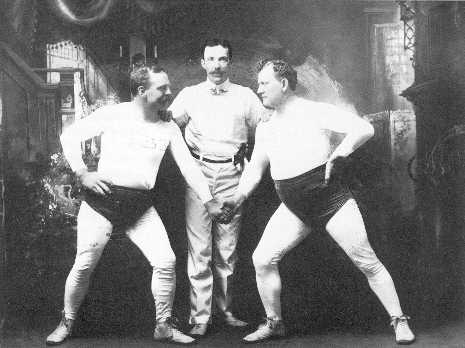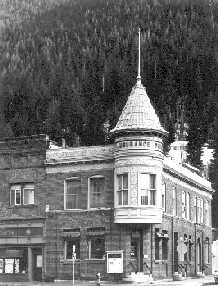HISTORIC WALLACE PERSONALITIES
Herman J. Rossi
[Excerpted
from Patricia Hart & Ivar Nelson, Mining Town:
The Photographic
Record of T.N. Barnard and Nellie Stockbridge
from the Coeur
d'Alenes
(Seattle and London: University of
Washington Press
& Boise: Idaho State Historical Society, 1984:
pp. 140-144),
permission pending.]
Wallace's wide-open nightlife could not have existed
without the acquiescence, of its politicians and leading
citizens. Herman J. Rossi was both, and his political career
was to intermingle with Wallace history over forty years.
He was an extraordinary personality who was four times
mayor of Wallace, a state representative, a regent of the
University of Idaho, chairman of the Idaho Board of Edu-
cation, president of the Wallace Board of Trade, lieutenant
colonel in the Idaho National Guard, and a successful
insurance executive and mine owner. His respectable career
becomes exceptional in the context of his having, during
this same period, publicly shot and killed a man, for which
he was found not guilty by reason of temporary insanity,
and his later being convicted of large-scale violations of the
federal Prohibition (Volstead) Act.
As were many other self-made men of this time,
ELKS BOXING TEAM (1902). Two boxers from the Elks Club and their coach pose before a Victorian backdrop in the Barnard Studio. Herman Rossi is the boxer on the left.
Rossi was a strong-willed individual. This and his hot temper
got him into trouble in 1916. His second wife, who was fifteen
years younger than he, had a drinking problem that wors-
ened during their marriage. Although attempts were made,
there seems to have been no cure for her alcoholism. On
June 30, 1916, Rossi returned from a Republican state
platform meeting in Boise to find his wife drunk in her bed-
room and the maid full of tales of debauchery. Rossi stormed
downtown to the Samuels Hotel, where he assaulted his wife's
supposed lover in the lobby and then shot him in the back as
he tried to run away. Rossi went to his attorney's office where
he was arrested, taken to the police station, booked, and
released on $10,000 bail put up by some of the town's most
prominent citizens.
Three and a half months later, Rossi was unanimously
found not guilty by reason of temporary insanity by a
hometown jury after less than twenty minutes' deliberation.
The judge, W. W. Woods, was a fellow Elk and Mason
and a co-director with Rossi in the Amazon Dixie Mine.
There was never any question that Rossi shot the man, but
there was a general community feeling that he had been
grievously wronged and had made just retribution. Demon-
strating their love for sensation and a flair for paradox, the
people of Wallace turned out in such large numbers for the
funeral of the victim that it was the best-attended event
held up to that time in Wallace.
Fully exonerated, Rossi continued his energetic career.
The next year, he married Bernice Johnson of Boise in
May and in July was organizing a citizens' alliance in
Wallace to collect Red Cross soldiers' relief funds and to
warn German sympathizers to leave town.
The story of Rossi's wife's alcoholism would have made
fit propaganda for the very active proponents of Prohibi-
tion, who on January 1, 1916, succeeded in making Idaho
a dry state. Ironically, Rossi was heavily involved in keep-
ing Shoshone as 'wet" as possible, and eventually was con-
victed for his involvement.
At the height of Idaho's anti-liquor sentiment in 1916,
Shoshone County was less enthusiastic about Prohibition
than was the rest of the state. Miners have traditionally
been hard drinkers, and the miners of the Coeur d'Alenes
were no exception. Evasion of state and then federal Pro-
hibition became common, and even blatant, in the district
for the next seventeen years. During the first few years of
Idaho state prohibition, the mining district received its
alcohol by a weekly train from Montana, which was still
wet, and from occasional pack trains that smuggled liquor
in across the mountains. It was clear that the Shoshone
County sheriffs were expected not to enforce the law, under
pain of popular retaliation.
Because of his involvement in city politics, Rossi was
aware that liquor licenses, upon which the city and the
county depended for much of their revenue, were trans-
formed into 'soft drink' licenses at the time of state prohibi-
tion in 1916. When he was elected mayor for the third time
in 1929, Rossi became an active participant in this long-
standing, large-scale, and quite open defiance of state and
federal laws.
The county's obvious evasion of the law did not go un-challenged. On August
14, 1929, federal and state agents coordinated arrests throughout the county, arresting
Rossi purchased what there after became known as the Rossi Building in 1917.
forty offenders and confiscating 600 gallons of liquor in their attack on what they called "the North Idaho
Whiskey Rebellion." Although this taxed the capacity of the county jail, it was just the beginning. Before the liquor agents were finished,
federal undercover
agents had arrested almost 200 county residents,
including Shoshone County Sheriff R. E. Weniger,
the deputy sheriff, the county assessor, and city and
police officials from both Mullan and Wallace, including
Mayor Rossi.
The charges left little doubt, that there was wholesale
and concerted evasion of the Volstead Act in Shoshone
County. The county and its principal cities had openly
licensed saloons at $25 a month under the thin disguise of
soft drink parlors. Local officials maintained that such
revenues went to legitimate city projects, in line with the
conventional Shoshone County belief that taxation of "vice"
was essential to funding local government. While the
morality of the system was debatable, its effectiveness was
not. In 1911, for example, the sheriff reported clearing
$100,000 in license revenue for the year. As State Repre-
sentative Adam Aulbach argued in a speech against the
'drys" in the Idaho House in 1905, prohibition invited
"commercial suicide"and liquor-license revenue was "indis-
pensable and irreplaceable."
But in 1929 the federal courts did not agree. Very few
of those arrested were acquitted. Sheriff Weniger was sen-
tenced to two years in the federal penitentiary and Rossi to
a year and a half. The latter never served his sentence but
did resign as mayor.
- In 1935, Herman Rossi was elected to his fourth term
as mayor of Wallace, a true representative of the people of
the town. Two years earlier, in the fall of 1933, Idaho had
voted against Prohibition; Shoshone County led the way
with a vote of 3,181 to 357.
authored by Ron Roizen, Ph.D.
go to
Historic
Wallace Preservation Society homepage...
